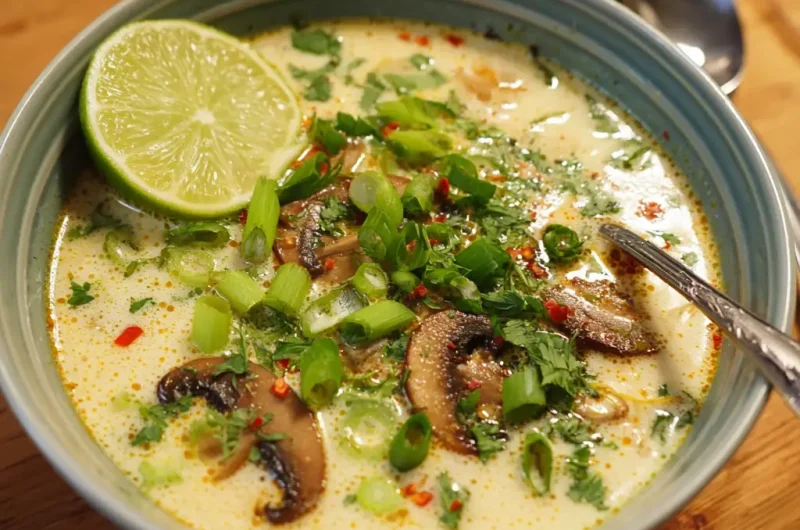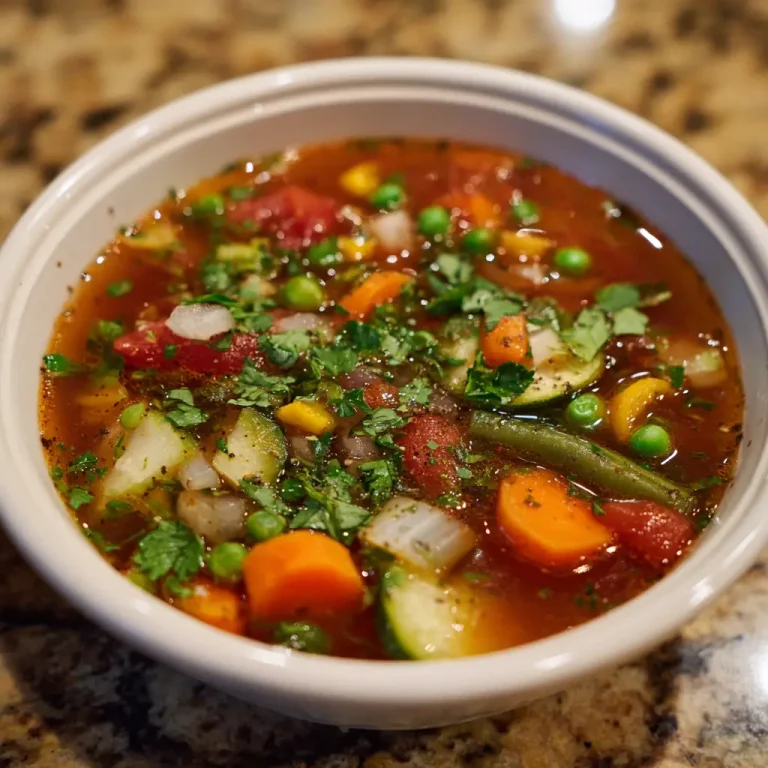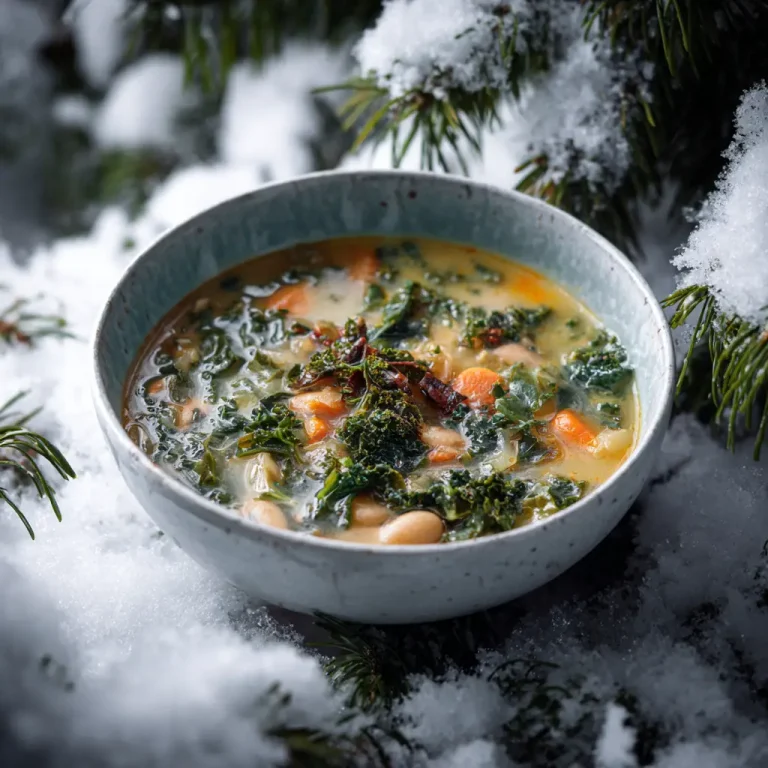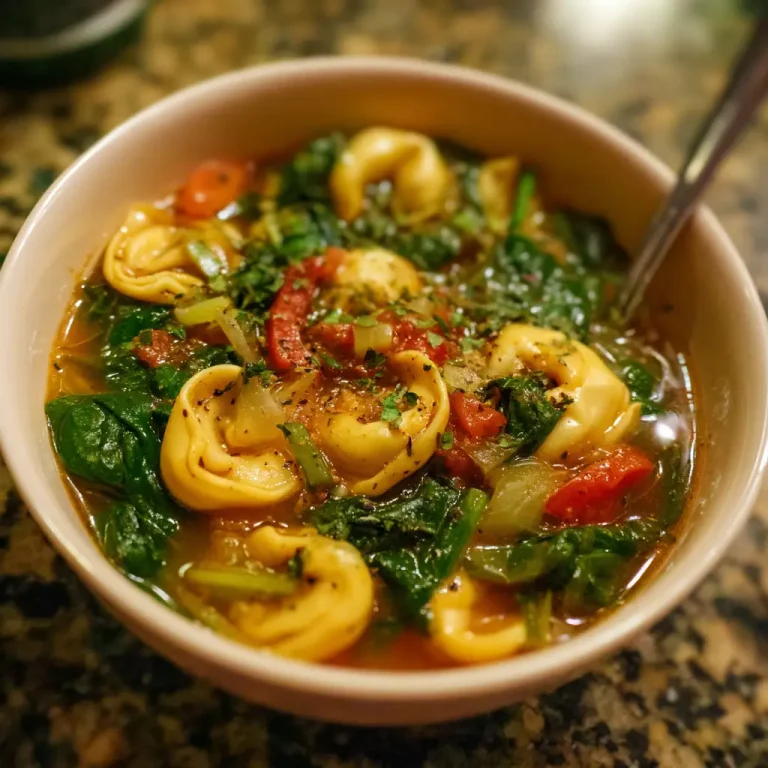Thai Coconut Soup Recipe | Authentic, Creamy, and Easy Homemade Thai Soup
Introduction
Imagine the gentle swirl of creamy coconut milk, the bright hit of lime juice, the warm hum of aromatic lemongrass and galangal, and a hint of chili tapping on your taste buds. That is the magic of Thai coconut soup—sometimes known by its traditional name, tom kha—but this version brings that soul into your home kitchen in a way that feels accessible and deeply satisfying. The balance between rich and light, spicy and soothing, makes it a dish that works just as well when you crave comfort as when you want something exotic yet familiar. The creamy broth glides across the tongue, carrying slices of tender chicken or mushrooms depending on your choice, while the herbs and citrus anchor the experience in fresh, vibrant flavour. Whether you are hosting a relaxed dinner or simply craving something warm and restorative after a long day, this soup offers a little culinary escape to the heart of Thai cuisine.
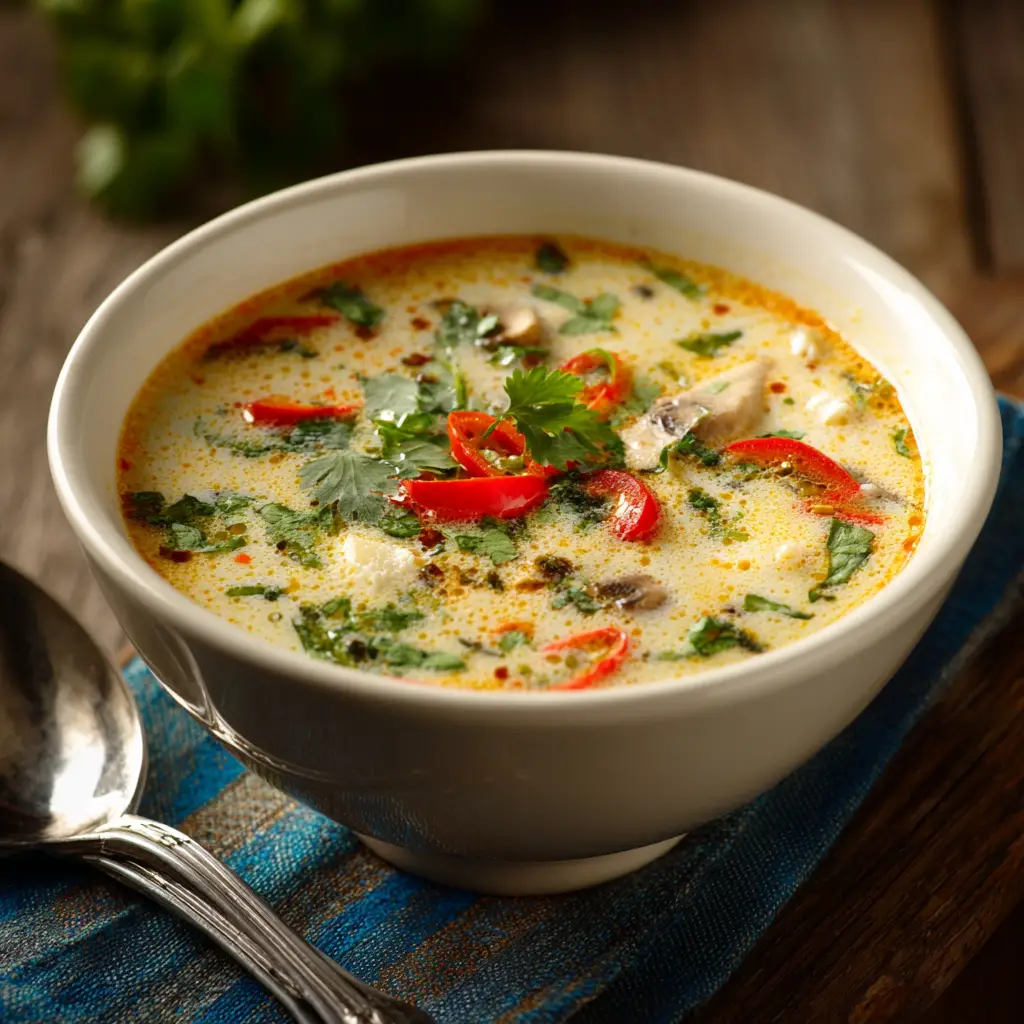
Ingredients Needed
Here is a table of the ingredients and approximate calorie counts per serving (note: values are estimates and will vary based on brand, portion size, and additions).
| Ingredient | Approximate Calories per Serving* |
|---|---|
| Coconut milk (full-fat, about ½ can) | ~200 kcal |
| Chicken broth or stock (1 cup) | ~15 kcal |
| Chicken breast (100 g) | ~165 kcal |
| Mushrooms (e.g., 100 g) | ~15 kcal |
| Lemongrass stalks, galangal (aromatics, negligible calories) | ~5 kcal |
| Kaffir lime leaves (aromatics) | ~2 kcal |
| Red curry paste (1 Tbsp) | ~30 kcal |
| Fish sauce (1 Tbsp) | ~10 kcal |
| Lime juice (½-1 lime) | ~5 kcal |
| Fresh cilantro or Thai basil garnish | ~2 kcal |
| Optional vegetables (e.g., baby corn, broccoli, 50 g) | ~20 kcal |
* Total estimated calories for one serving of soup: about ~265-300 kcal (for a version with chicken and full-fat coconut milk). Some versions report higher depending on extra coconut milk or rice/noodles added.
Step-by-Step Cooking Instructions
- Begin by preparing your aromatics. Trim and lightly bruise the lemongrass stalk (white part only) so it releases flavour. Slice a piece of galangal (or substitute fresh ginger if needed) and slightly tear kaffir lime leaves if available. These are foundational to the fragrance of the soup.
- In a medium-sized pot, add 1 tablespoon neutral oil over medium heat. Add chopped onion or shallot, garlic cloves (minced), the lemongrass, galangal (or ginger), and the curry paste. Stir and sauté for about 1-2 minutes until the mixture is fragrant.
- Pour in the chicken broth (or vegetable broth if making a vegetarian version) and bring to a gentle simmer. Let the aromatics infuse for about 5–10 minutes. This step allows the lemongrass, galangal, and lime leaves to impart depth of flavour.
- Add the coconut milk and stir gently. Return to a gentle simmer (avoid a rolling boil so the coconut milk does not separate). At this stage you may add your main protein (sliced chicken breast) or mushrooms, depending on your preference. If using raw chicken slices, simmer until the meat is cooked through (about 5 minutes), adding mushrooms and other vegetables (e.g., baby corn, broccoli florets) for the last few minutes.
- Now episode the fish sauce and lime juice. Add about 1–2 tablespoons fish sauce, and the juice of half to one lime depending on your taste. Adjust with a pinch of sugar or palm sugar if you like a touch of sweetness to balance the savoury and sour. Taste and adjust seasoning: more fish sauce for saltiness, more lime for brightness, more curry paste or chili for heat. 1
- Remove the pot from heat when everything is cooked through and flavour balanced. Discard the large aromatics (lemongrass stalks, lime leaves, galangal slices) if you didn’t mince them. Serve hot, garnished with freshly chopped cilantro or Thai basil, with lime wedges on the side.
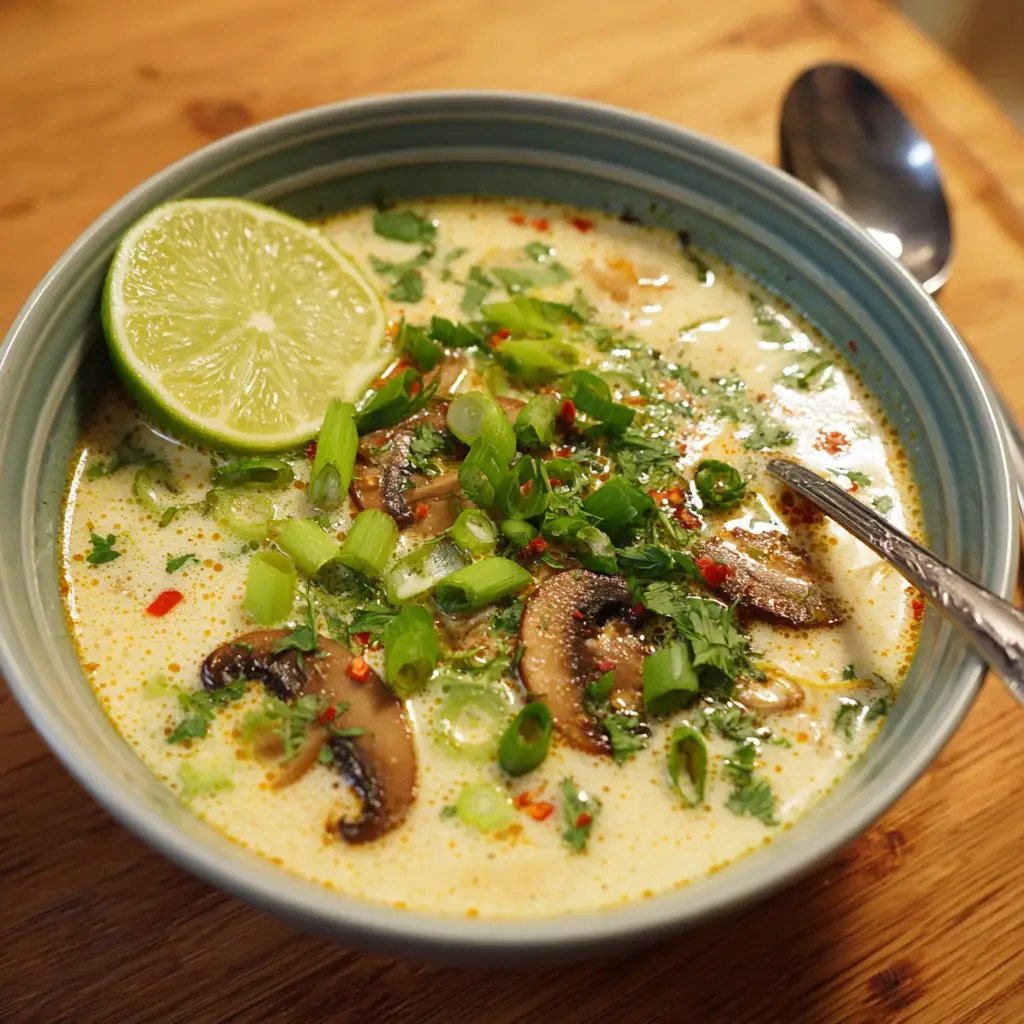
Tips for Customizing the Recipe
- Protein swap: Replace chicken with shrimp, tofu, or simply leave it out for a vegetarian version. The base broth remains richly coconut-flavoured.
- Vegetable add-ins: Feel free to add baby corn, broccoli florets, bell pepper strips, spinach or pak choi to increase veg content. A quick sauté or blanch works fine. For mushrooms, shiitake or oyster add an earthy depth
- Heat level: Increase the number of Thai bird’s eye chilies (or red chilli slices) or add a teaspoon of chilli garlic paste or red curry paste to ramp up spice. For a milder version, use only one mild chilli or none at all.
- Coconut milk choice: Using full-fat coconut milk yields a velvety texture. If you want lighter calories, substitute part of the coconut milk with light coconut milk or coconut water plus a splash of milk, knowing the richness will reduce.
- Acidity and freshness: Always finish with fresh lime juice just before serving rather than during the long simmer. It preserves the brightness. Fresh herbs like cilantro, Thai basil or scallions make a noticeable difference.
- Serving variation: Serve over cooked jasmine rice, rice noodles or vermicelli for a more substantial meal. If you prefer a soup alone, reduce or omit starch.
- Vegetarian/vegan modification: Use vegetable or mushroom broth instead of chicken broth, and replace fish sauce with soy sauce or a vegan “fish” sauce alternative for umami. Add tofu instead of chicken.
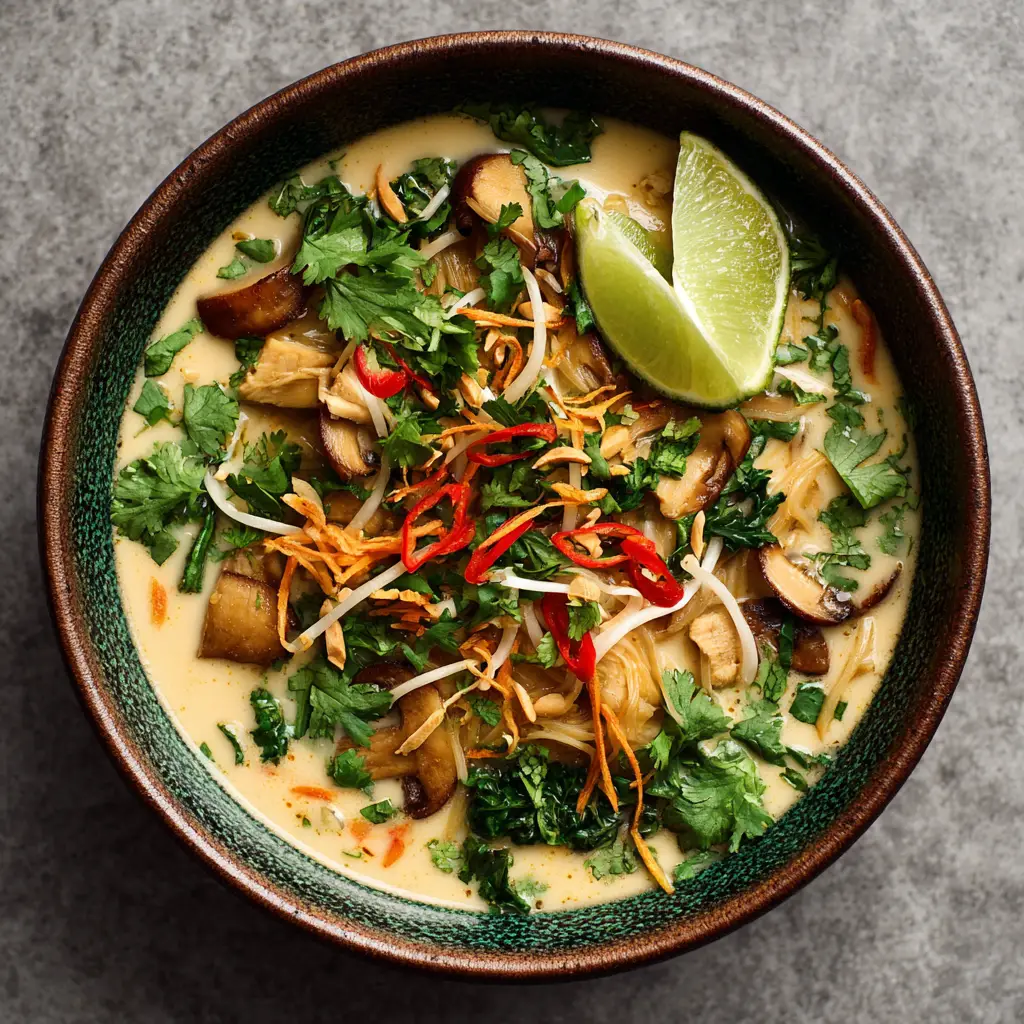
Nutritional Information
Here is an approximate overview based on one serving of the classic version (including chicken, full-fat coconut milk, basic vegetables):
Serving Suggestions
- Serve the soup hot in shallow bowls accompanied by steamed jasmine rice or fragrant basmati rice for classic Thai style. The rice helps soak up the creamy broth.
- For a lighter feel, serve the soup on its own with a side of fresh cucumber salad dressed with lime and fish sauce – the crisp coolness contrasts beautifully with the warm soup.
- Garnish generously with fresh cilantro, Thai basil, lime wedges and if you like extra heat, thin slices of red chilli or a drizzle of chilli oil. The garnish brings freshness and visual appeal.
- For a special occasion, you could accompany the soup with Thai spring rolls or fresh summer rolls to start, then the coconut soup as the main.
- Leftovers: Store refrigerate in an airtight container. Reheat gently; if the coconut oil has separated, stir it back in. Add fresh lime juice and herbs at serving time to revive the flavours.
- Beverage pairing: A chilled glass of light white wine (e.g., a Riesling or Sauvignon Blanc) or a lemongrass iced tea works nicely to balance the soup’s richness. If you prefer non-alcoholic, try sparkling water with lime.
Thai Coconut Soup Recipe | Authentic, Creamy, and Easy Homemade Thai Soup
Course: Blog4
servings15
minutes20
minutes280
kcalIngredients
IngredienttQuantity
Coconut milk (full-fat)t1 can (400 ml)
Chicken broth (or vegetable broth)t2 cups
Chicken breast (thinly sliced)t200 g
Fresh mushrooms (sliced)t1 cup
Lemongrass stalks (white part only, bruised)t2
Galangal or fresh ginger (sliced)t5–6 slices
Directions
- Prepare Aromatics
- Lightly bruise the lemongrass stalks and slice the galangal or ginger. Tear kaffir lime leaves to release their aroma.
- Sauté Base Flavors
- Heat a tablespoon of oil in a pot over medium heat. Add red curry paste, lemongrass, galangal, and kaffir lime leaves. Stir for about one minute until fragrant.
- Add Broth
- Pour in the chicken broth and bring it to a gentle simmer. Let the aromatics infuse for about 5–10 minutes.
- Add Coconut Milk and Protein
- Stir in the coconut milk and bring back to a gentle simmer. Add sliced chicken breast and cook until the meat is tender and fully cooked (about 5 minutes).
Recipe Video
Notes
- For a vegetarian version, use vegetable broth and replace fish sauce with soy sauce or a vegan fish sauce alternative.
Avoid boiling the soup too hard to keep the coconut milk from separating.
FAQs
What if I cannot find lemongrass or galangal?
You can substitute fresh ginger for galangal (though the flavour is somewhat different) and use a pinch of lemon zest plus a stalk of fresh lemongrass if available. Some recipes allow lemon peel plus ginger in a pinch.
Can I make the soup ahead of time?
Yes, you can prepare the broth and aromatics ahead and store in the fridge. When ready to serve, add the coconut milk, protein, vegetables, and finish with lime juice and herbs. Keep fresh herbs separate until just before serving for best flavour.
Is this soup gluten free?
Yes—provided you use gluten-free broth and ensure that any curry paste or fish sauce you use is certified gluten free. The core ingredients (coconut milk, lemongrass, galangal) are naturally gluten free.
How can I reduce the calories without losing flavour?
Use light coconut milk or replace part of the full-fat version with a lower-fat milk, reduce or skip rice/noodles, load up on vegetables, and use lean protein like chicken breast or tofu. Also watch the fish sauce and salt levels as sodium can make you retain water.
Why is my coconut milk separating when I heat the soup?
Coconut milk can split if boiled aggressively. To avoid this, bring to a gentle simmer rather than a rolling boil, and heat slowly. Remove from heat before serving and stir gently.
Can I freeze this soup?
You can freeze it without the fresh herbs and lime juice, but freezing may alter the texture of the coconut milk (it may separate). When reheating, stir well and add fresh herbs and lime juice to restore freshness.
Conclusion
Warm, fragrant, and full of character, this Thai coconut soup brings a taste of Thailand into your kitchen in a way that is approachable yet deeply satisfying. It brings together creamy coconut, bright citrus, bold aromatics and tender protein or vegetables in a single bowl of comfort. Once you’ve mastered the base, you can customise it endlessly to your preferences and dietary needs—whether lighter, vegetarian, or extra spicy. Let each spoonful take you somewhere special, and may your next bowl be filled not just with soup but with flavour, warmth and enjoyment.

